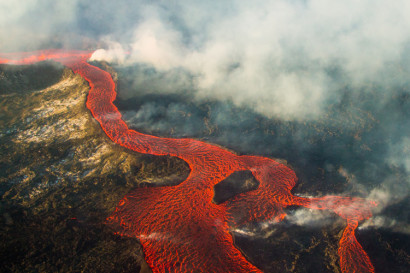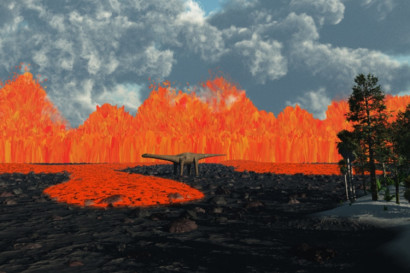Decade-long volcanic eruptions may not have caused global extinctions
Sulfur emissions from years-long lava eruptions, one of the proposed causes of massive die-offs in earth's history, may have had less grim consequences than once thought
November 23, 2015
The climatic and environmental effects of lava flows and sulfur emissions that lasted for years or decades in earth’s past were likely much less severe than scientists once thought, according to a new study by scientists in Europe and the United States.

January 2015 photo of an active lava flow from the 2014-2015 flood lava eruption at Holuhraun in Iceland. Anja Schmidt photo, University of Leeds.
These so-called flood basalts, along with explosive supervolcano eruptions and asteroid impacts, have often been invoked, alone or in combination, to explain the five mass extinction events that have befallen earth over the past 300 million years, including the Cretaceous extinction that saw the demise of the dinosaurs 66 million years ago.
But while volcanic eruptions and asteroid impacts can propel gas and dust into the atmosphere and alter climate for years, the impact of years of sulfur dioxide emissions from flood basalt lava flows – including acid rain and fog – is unknown. At their peak, such eruptions would have filled 150 Olympic-size swimming pools every minute.
A global model simulation of the spread of the gas and aerosol particles combined with data on several past eruptions suggests that the reality during and after such an eruption was likely much less grim than assumed. Only if such flood basalts oozed for hundreds of years without interruption might the climatic impacts have had a more severe effect on plants and animals, the researchers concluded.
“Perhaps most intriguingly, we found that the effects of acid rain on vegetation were rather selective; that is, vegetation in some but not all parts of the world would have died off, whereas in other areas the effects would have been negligible,” said study leader Anja Schmidt, an academic research fellow in the School of Earth and Environment at the University of Leeds in the United Kingdom.

Lava fountaining above the volcanic fissure of the Holuhraun flood lava eruption in Iceland in September 2014, a small-scale analog to the eruptions in the Deccan Traps, 66 million years ago. Michelle Parks photo, University of Iceland.
The new findings will challenge the earth sciences community as a whole to re-examine the causes of mass extinctions and the role of volcanism, said co-author Stephen Self, an adjunct professor in the Department of Earth and Planetary Sciences at UC Berkeley.
“It’s a possibility that volcanism was involved, but that sulfur gases were not the main agent, as has been suggested by other workers in recent years,” he said. “The results are not unexpected considering recent work on aerosol particles from other types of eruptions, but now we have to put on our thinking caps to understand what about these massive lava flows, if not sulfur, leads to widespread plant and animal die-offs.”
The scientists published their new study online Nov. 23 in the journal Nature Geoscience.
Volcanic fogs and acid mists
The team of earth scientists used information on the duration and intensity of continental flood basalt eruptions, such as the Columbia River Basalt Group from 16.5-14.5 million years ago and the Deccan Traps eruptions 66 million years ago, to estimate the climatic and environmental effects of the huge quantities of sulfur dioxide gas emitted by these eruptions. The global aerosol model showed that temperatures on earth were indeed cooler as a result of the eruptions – as much as 4.5 degrees Celsius (8 degrees Fahrenheit) cooler – but this cold snap lasted for only a few decades.
Flood basalts, a special type of volcanism that was bigger and longer in duration than any eruptions humans have ever witnessed, are one of the most hotly debated culprits proposed to cause mass extinctions. At the time when the dinosaurs reigned, numerous long-lasting eruptions took place over the course of about a million years or less. The largest of these, called the Deccan Traps, covered one-third of what is now India.

Artists impression of a typical flood lava eruption, including lava fountaining along a curtain of fire. Jonathan Poulter illustration, UK.
These continental flood basalt eruptions poured out huge amounts of volcanic gases, while lava gushed from the ground to create a curtain of fire. Each eruption likely lasted years to decades, but eruptions were separated by long periods without volcanic activity.
Some scientists have argued that as a result of the emitted volcanic gases, a long-lasting volcanic winter brought many species to the brink of extinction. These conditions were made even worse, presumably, by rain so acidic that vegetation and life in the ocean had little chance of survival.
Schmidt, Self and their colleagues found, instead, that a decade-long eruption on the scale of the Deccan Traps would cause a decadal-mean reduction in global surface temperature of 4.5 degrees Celsius, but that the temperature would return to normal within 50 years after an eruption ceased.
Acid mists and fogs could have caused immediate damage to vegetation in some regions, they said. But the soil and water chemistry would have prevented catastrophic damage to acid-sensitive land and marine ecosystems even if volcanic sulfur deposition persisted throughout century-long eruptions.
Schmidt noted that the conclusions are based on the assumption that climate feedbacks were very similar to those today.
“Our studies provide a quantitative estimate of the degree and nature of the effects that continental flood basalt eruptions had on the climate, vegetation and oceans,” she said. “We now need to better understand how long both the individual eruptions and the periods without volcanic activity lasted.”
Study coauthors are Richard A. Skeffington of the University of Reading; Thorvaldur Thordarson of the University of Iceland in Reykjavik and the University of Edinburgh in Scotland; Piers M. Forster, Alexandru Rap, Marjorie Wilson, Paul Wignall, Graham W. Mann and Kenneth Carslaw of the University of Leeds; Andy Ridgwell of the University of Bristol in the UK and UC Riverside; and David Fowler of the UK’s Centre for Ecology and Hydrology.
RELATED INFORMATION